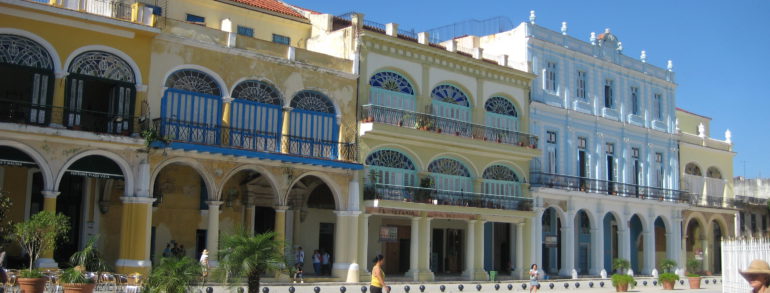Plazas, Cathedrals, Palaces & Convents
Plaza de la Catedral
The Cathedral Construction of a church on this site was begun by Jesuit missionaries at the beginning of the 18th century. After the Jesuits were expelled in 1767, the church was later converted into a cathedral. On either side of the Spanish colonial baroque facade are bell towers, the left one (west) being half as wide as the right (east). There is a grand view from the latter. The church is officially dedicated to the Virgin of the Immaculate Conception, however, is better known as the church of Havana's patron saint, San Cristóbal, and as the Columbus cathedral. The remains of Christopher Columbus were sent to this cathedral when Santo Domingo was ceded by Spain to France in 1795; they now lie in Santo Domingo. It was later discovered the bones were in fact those of another Columbus.
Open Mon-Tues and Thur-Sat 9:30 am - 12:30 pm, Sun 8:30 am - 12:30 pm, Mass at 10:30 am. Several days a week there is a handicraft market on the square in front of the Cathedral, and in adjacent streets.
Plaza de Armas
Plaza de Armas has been restored to very much what it once was. The statue in the centre is of Carlos Manuel de Cèspedes. In the NE corner of the square is the renovated church of El Templete; a column in front of it marks the spot where the first mass was said in 1519, under a ceiba tree. A sapling of the same tree, blown down by a hurricane in 1753, was planted on the same spot, and under its branches the supposed remains of Columbus reposed in state before being taken to the cathedral. This tree was cut down in 1828, the present tree planted, and the Doric temple opened. There are paintings by Vermay, a pupil of David, inside.
On the north side of the Plaza is the Palacio del Segundo Cabo, the former private residence of the Captains General, now housing the Feria Cubana del Libro. Its patio is worth a look.
Palacio de los Capitanes Generales
On the west side of Plaza de Armas is the former Palace of the Captains General, built in 1780, a charming example of colonial architecture. The Spanish Governors and the Presidents lived here until 1917, when it became the City Hall. It is now the Historical Museum of the city of Havana (open Mon-Sat 0930-1830, camera fee $3 USD) and houses a large collection of 19th century furnishings, portraits of patriots, flags, military memorabilia and a grandly laid out dining room. The building was the site of the signing of the 1899 treaty between Spain and the USA. The arcaded and balconied patio is well worth a visit.
The courtyard contains royal palms, the Cuban national tree. An extension to the museum is the Casa de la Plata, a silverware collection on Obispo entre Mercaderes y Oficios, fine pieces, jewelry and old frescoes on upper floor, free with ticket to Museo de la Ciudad. The former Supreme Court on the north side of the Plaza is another colonial building with a large patio. The Museum of the City was installed in the Palace of the Captains General, the stately baroque residence of the colonial Governors of Cuba for more than 100 years and the most impressive building on the Plaza de Armas (the former Parade Grounds).
This palace, built in 1791, was the seat of colonial power until 1898, when the Republic was created.
Between 1902 and 1920, it was the official residence of the Presidents of the Republic, and from 1920 to 1950, the headquarters of the City Government of Havana.
The museum's collections provide a panoramic view of the history of the city from the founding to the present. Its most important rooms are devoted to the Cuban wars for national independence.
The "Hall of Flags" contains the original Cuban flag and the one flown by Carlos Manuel de Cespedes when he began the first war for independence in 1868, as well as a number of flags used by the Spanish colonial government in Cuba. The art collection contains objects, paintings, porcelains, silver, bronzes and furniture of great historical value and beauty.
Collections: Art; History of Cuba; Ethnology; Archaeology; Folklore; Weapons.
Address: Calle Tacon e/ Obispo y O'Reilly, Habana Vieja
Open: Tuesday to Saturday: 11:30 am - 5:00 pm, Sundays: 9:00 am to 12:00 pm, Closed Mondays
The Church and Convent of San Francisco
Built in 1608 and reconstructed 1730, this is a massive, sombre edifice suggesting defense rather than worship. The three-story tower was both a landmark for returning voyagers and a look-out for pirates. The church is now a concert hall and the convent is a museum containing religious pieces. Restoration work is still going on. Most of the treasures were removed by the government and some are in museums.
Open daily 9:30 am - 6:00 pm, $2 USD, bell tower with stunning views of the city and port an extra $1 USD.
The Convento de Santa Clara
Founded in 1644, by nuns from Cartagena in Colombia, it was in use as a convent until 1919, when the nuns sold the building. In a shady business deal it was later acquired by the government and after radical alterations it became offices for the Ministry of Public Works until the decision was made to restore the building to its former glory.
Work began in 1982, and is still continuing. The Convent occupies four small blocks in Old Havana, bounded by Calles Habana, Sol, Cuba and Luz, and originally there were three cloisters and an orchard. You can see the cloisters, the nuns' cemetery and their cells. The first cloister has been carefully preserved; the ground floor is a grand portico stone gallery surrounding a large patio packed with vegetation, in it are the city's first slaughter house, first public fountain and public baths. The Sailor's House in the second cloister, reputedly built by a sailor for his lovelorn daughter is now a Residencia Acadèmica for student groups (and independent travelers if room).
Open Mon-Fri 9:00 am - 3:00 pm, $2 USD for guided tour in Spanish or French, entrance on Cuba.
La Plaza Vieja
An 18th century plaza, undergoing restoration since February 1996, as part of a joint project by UNESCO and Habaguanex, a state company responsible for the restoration and revival of old Havana. The former house of the Spanish Captain General, Conde de Ricla, who retook Havana from the English and restored power to Spain in 1763, can be seen on the corner of San Ignacio and Muralla. As restoration continues, 18th century murals are being uncovered on the external walls of the buildings, many of which boast elegant balconies overlooking the plaza. Art exhibitions in the colonial house on the corner of San Ignacio and Brasil. The newly-restored Cuban Stock Exchange building, La Lonja, Oficios and Plaza San Francisco, is worth a look, as is the new cruise ship terminal opposite.
Iglesia de La Merced
Construction of this church began 1755, and was still incomplete 1792, when work stopped. Building was completed late in the 19th century. It has an unremarkable exterior and a redecorated lavish interior.

